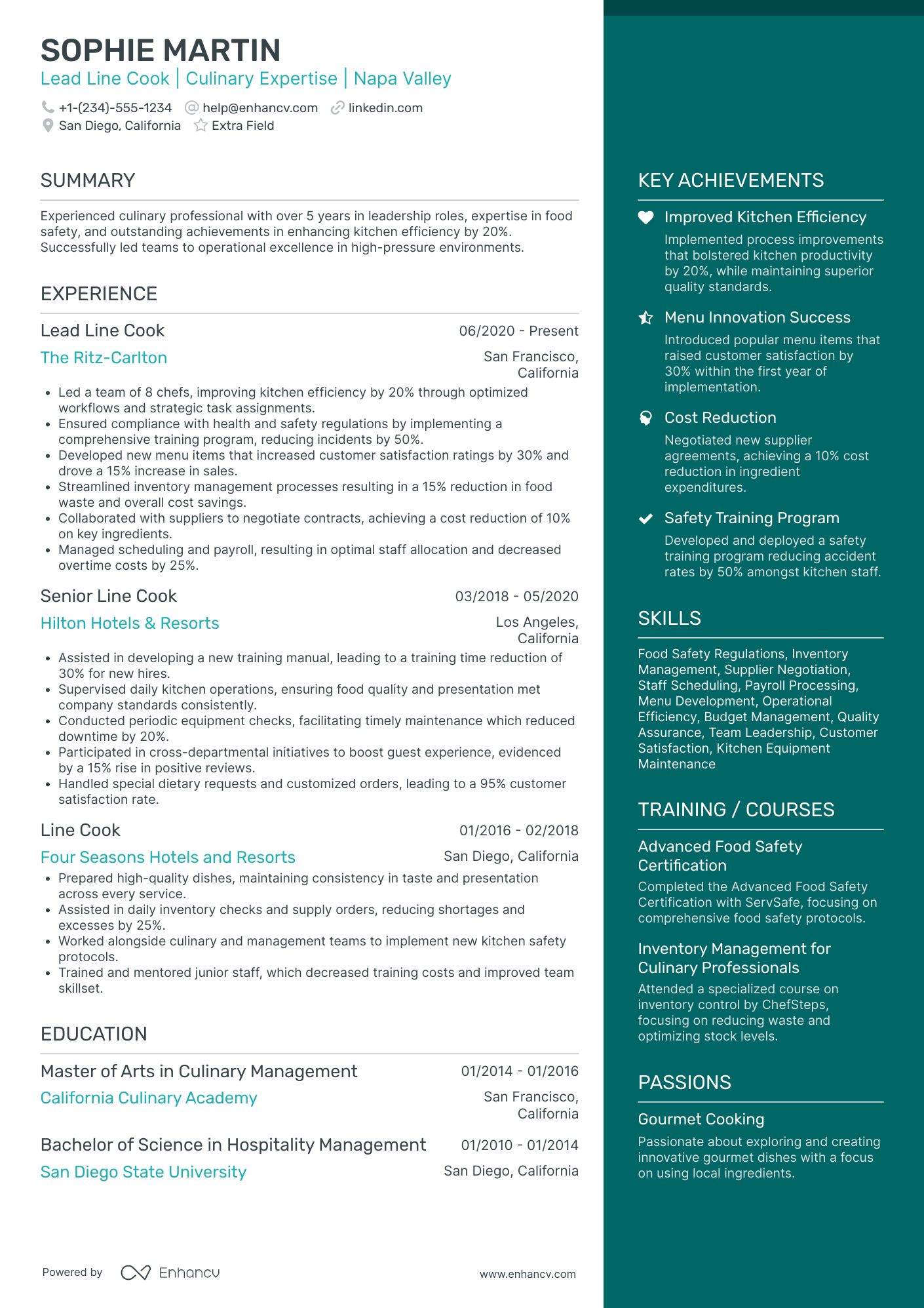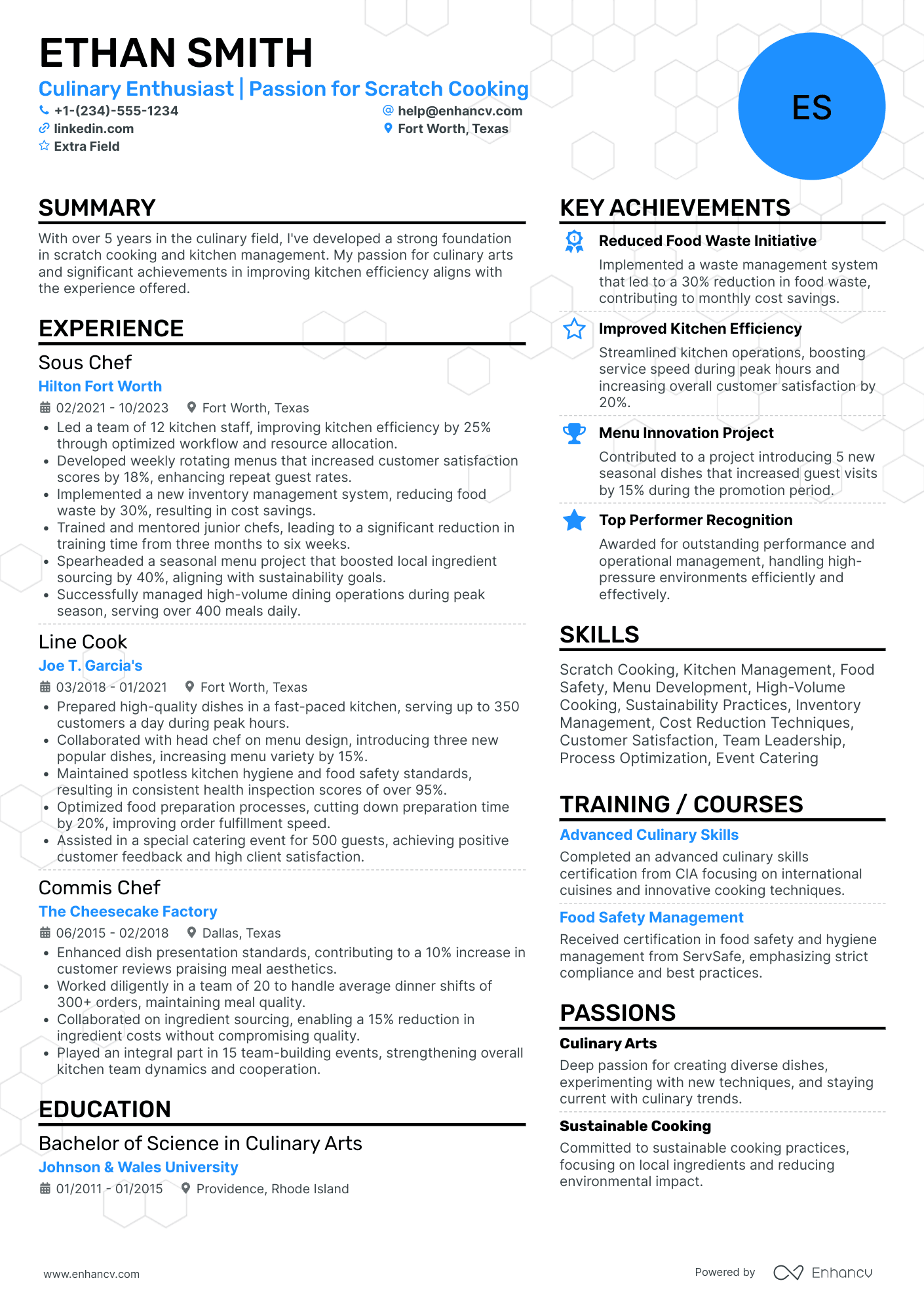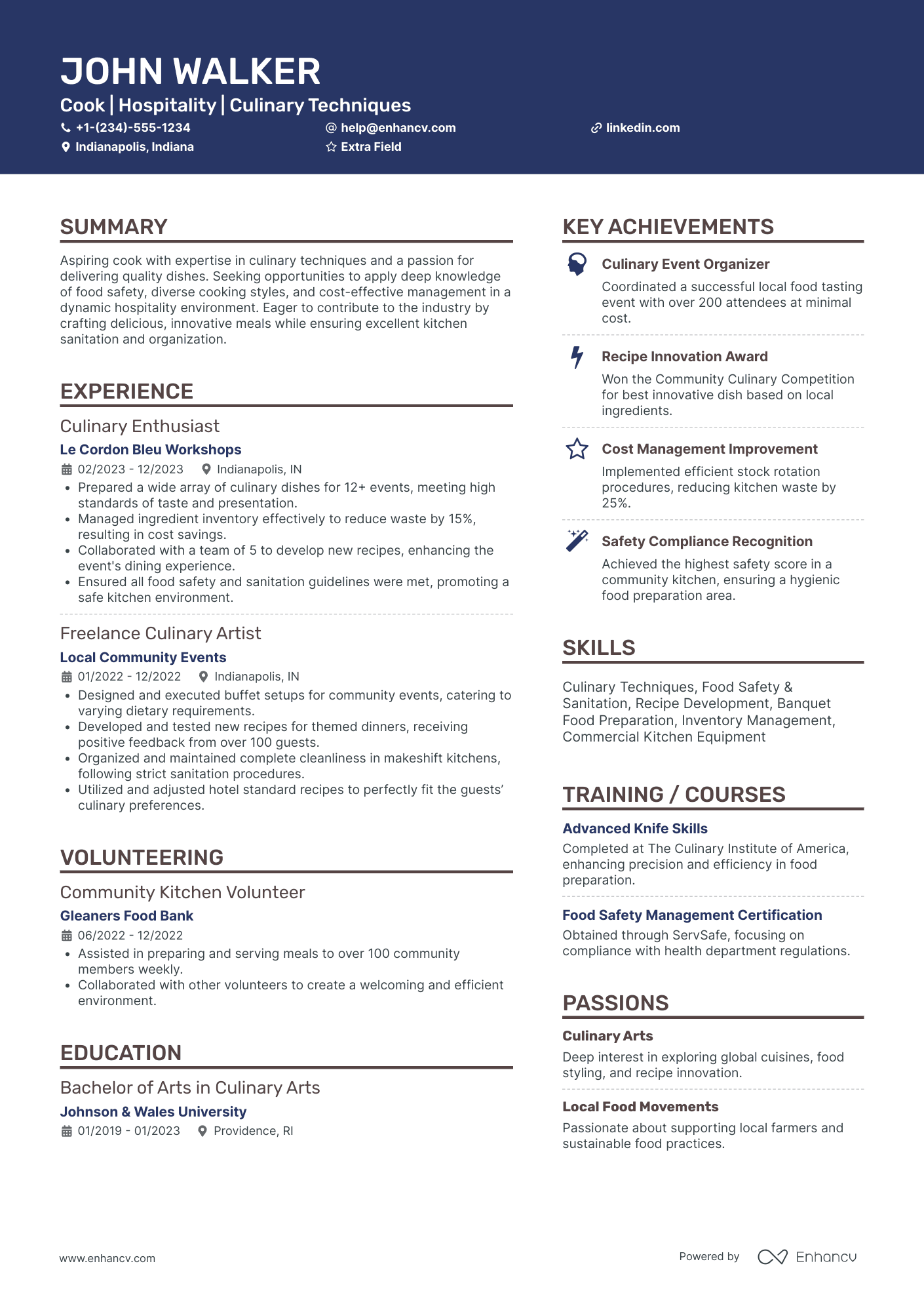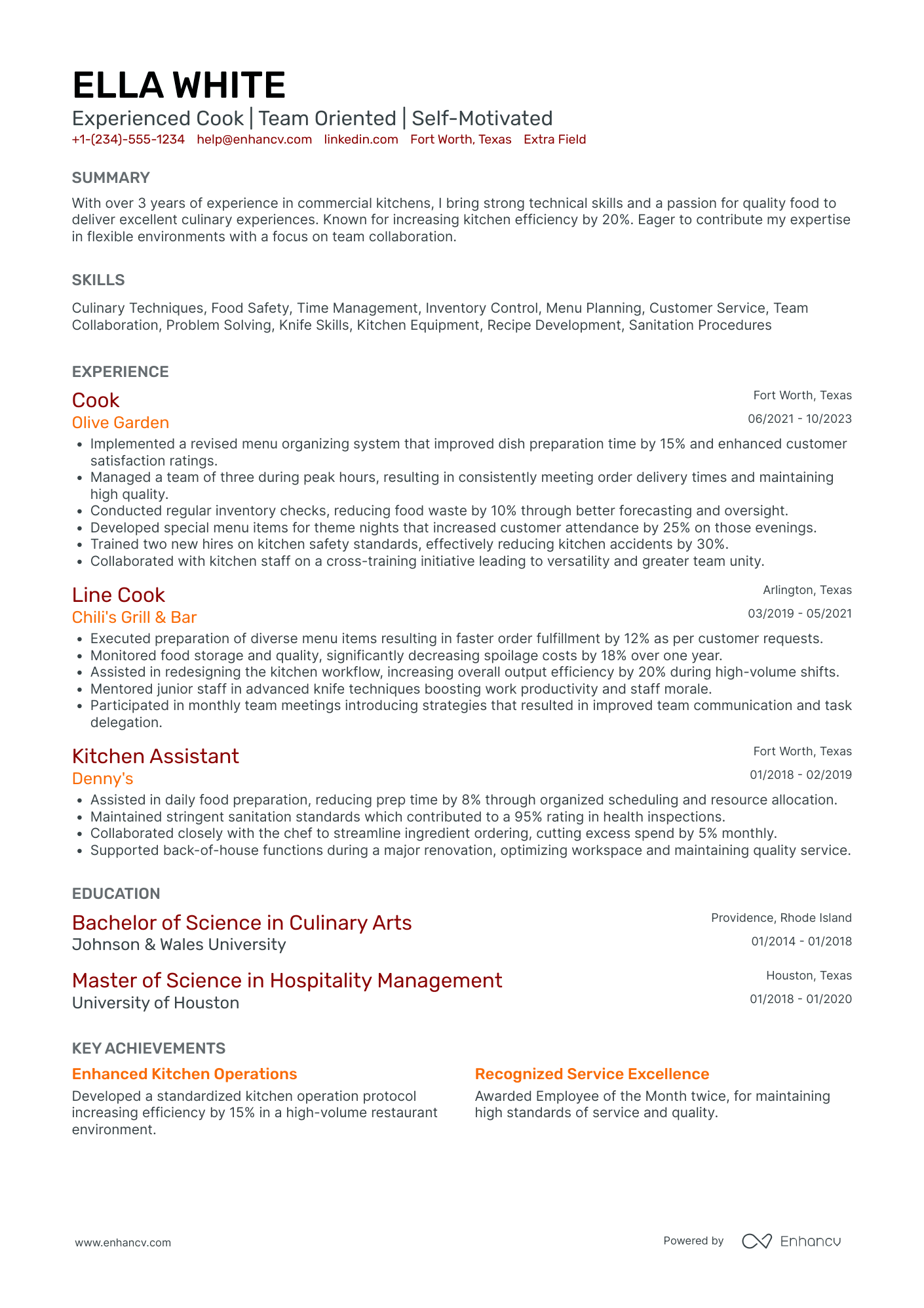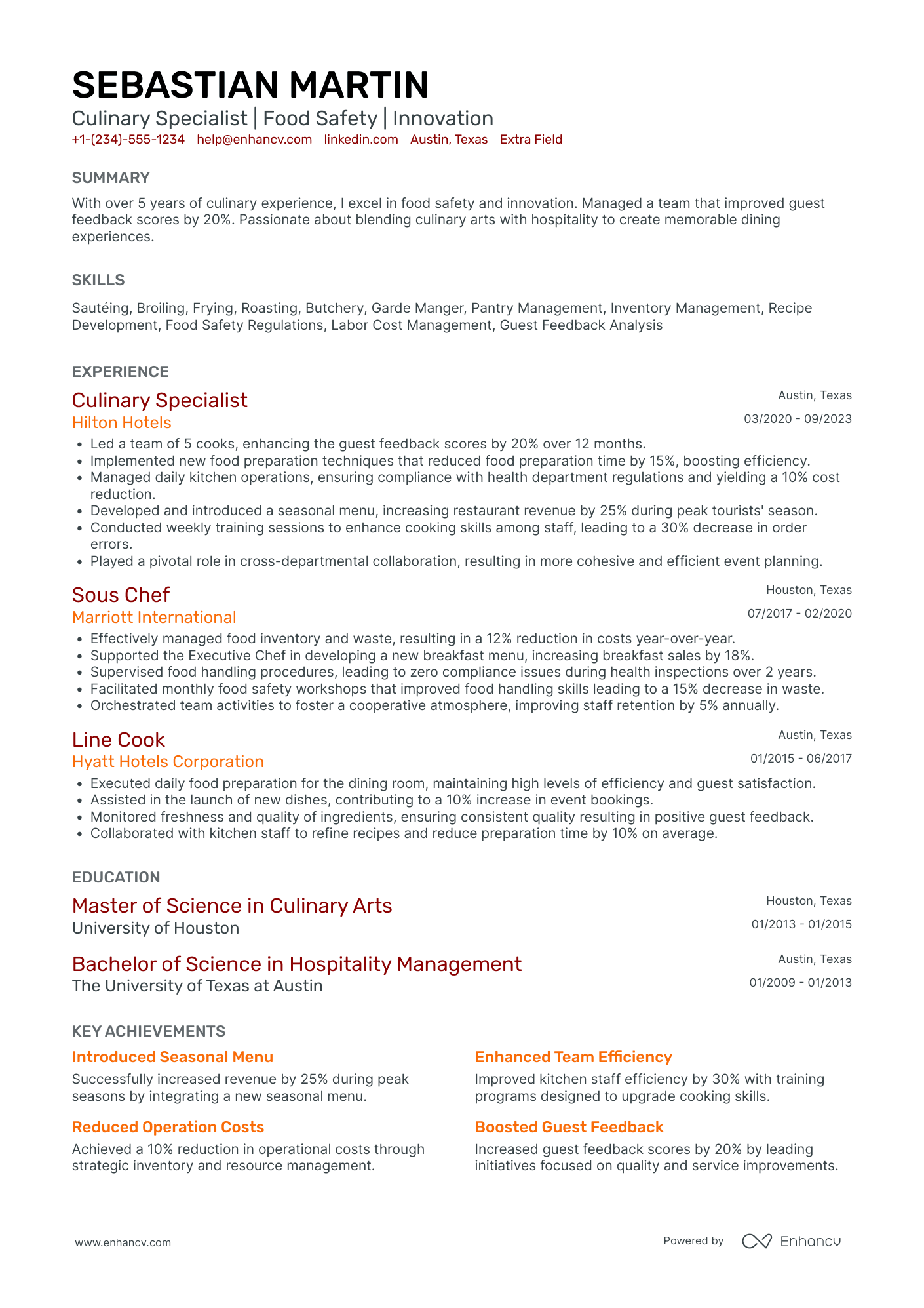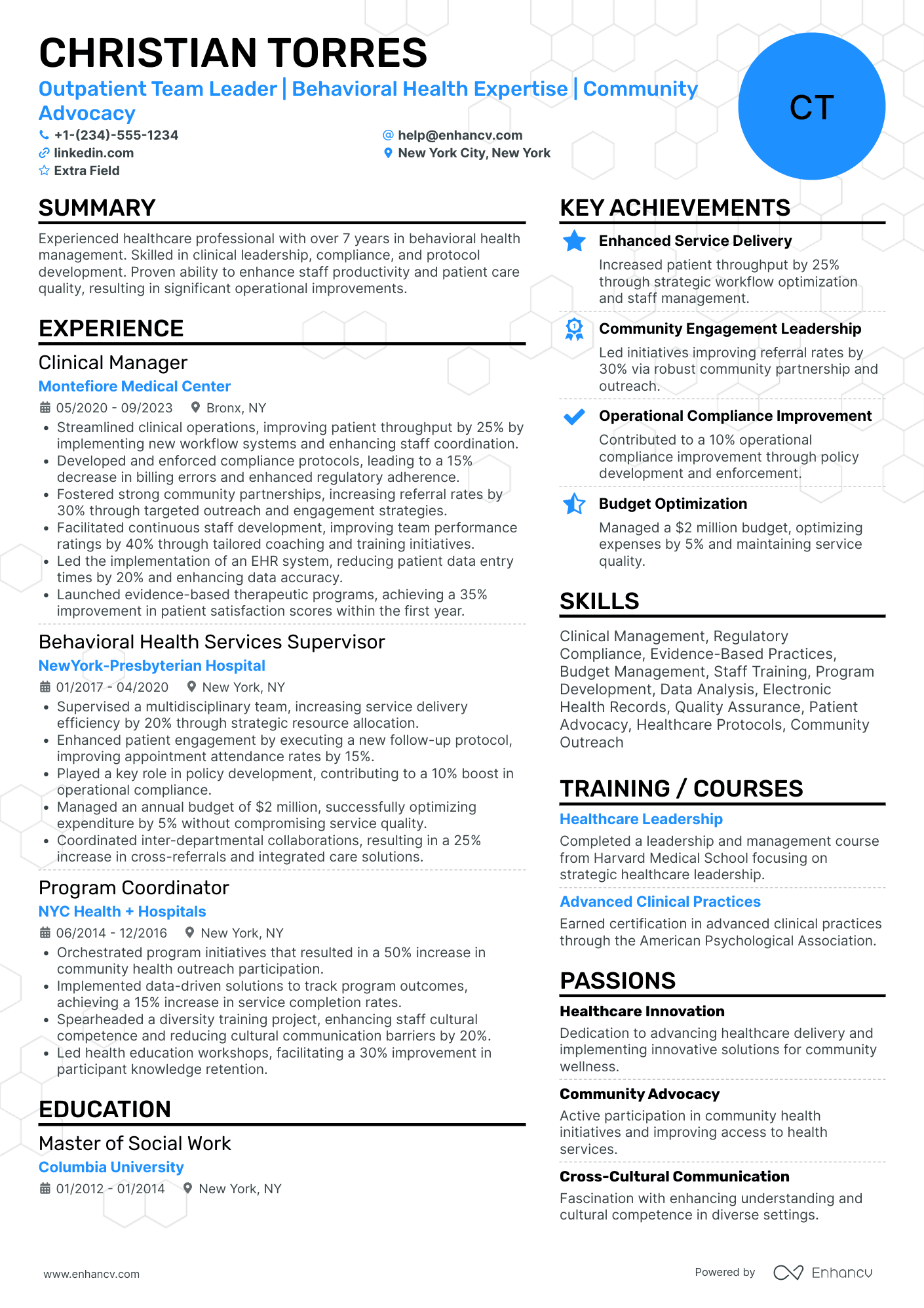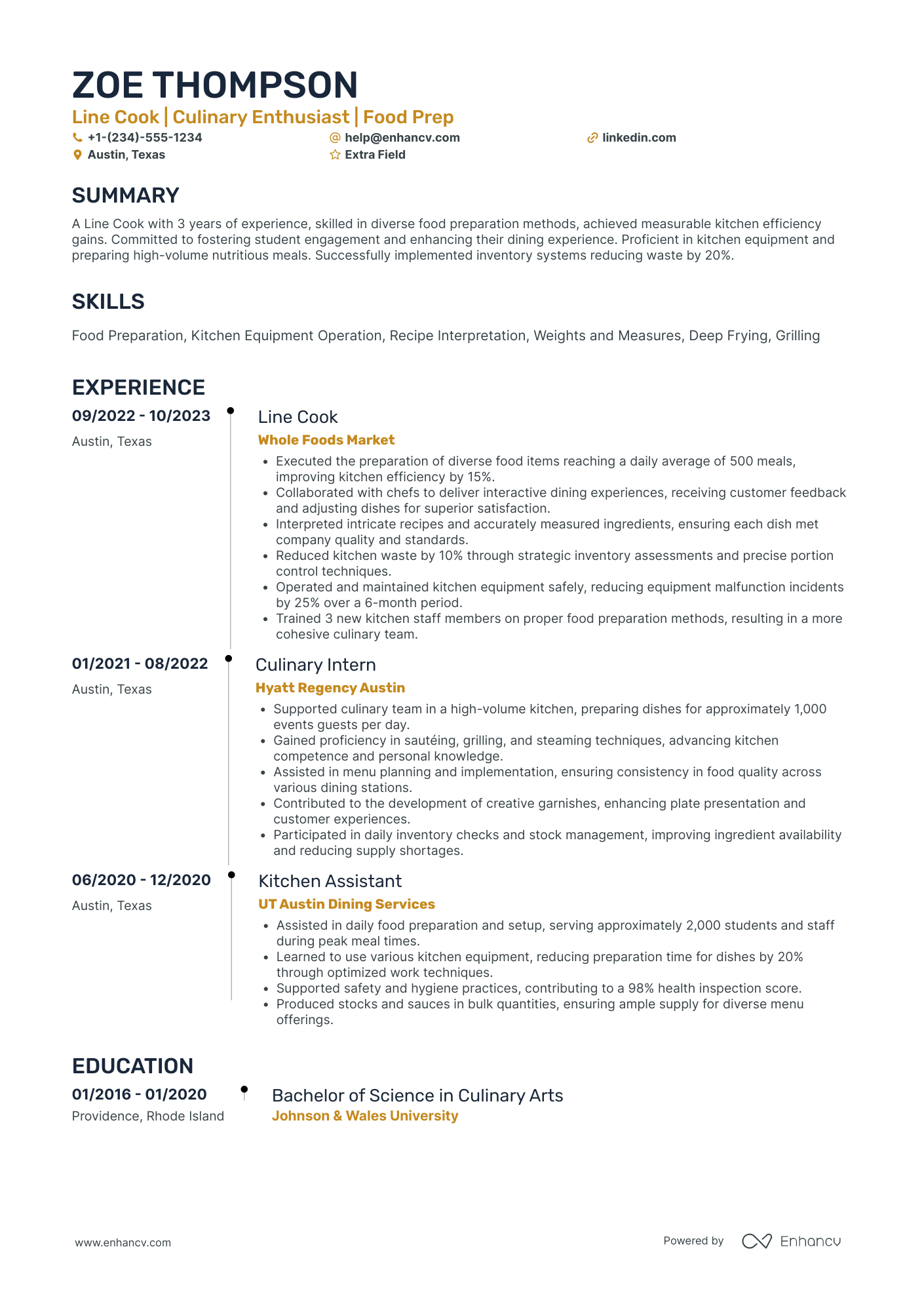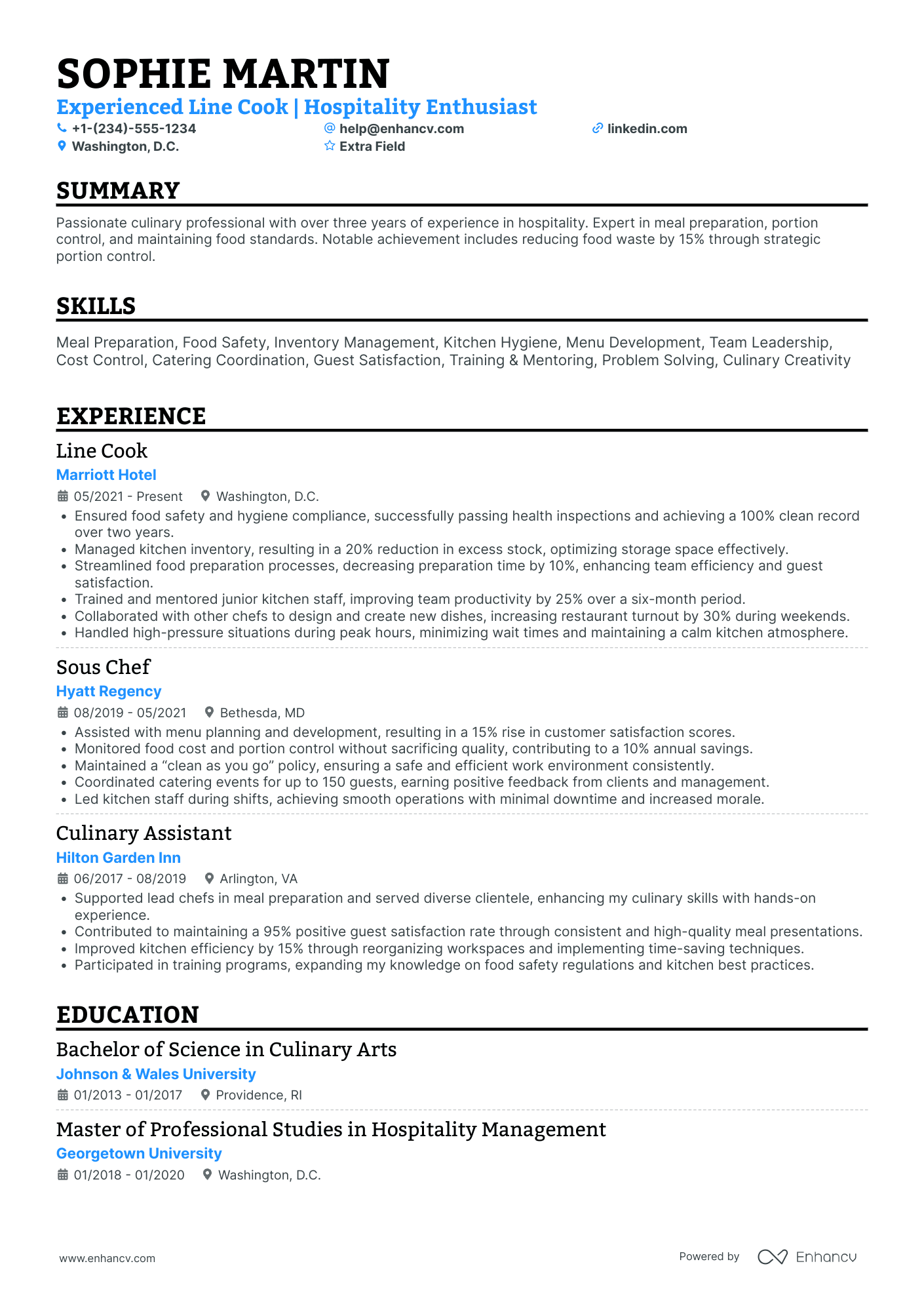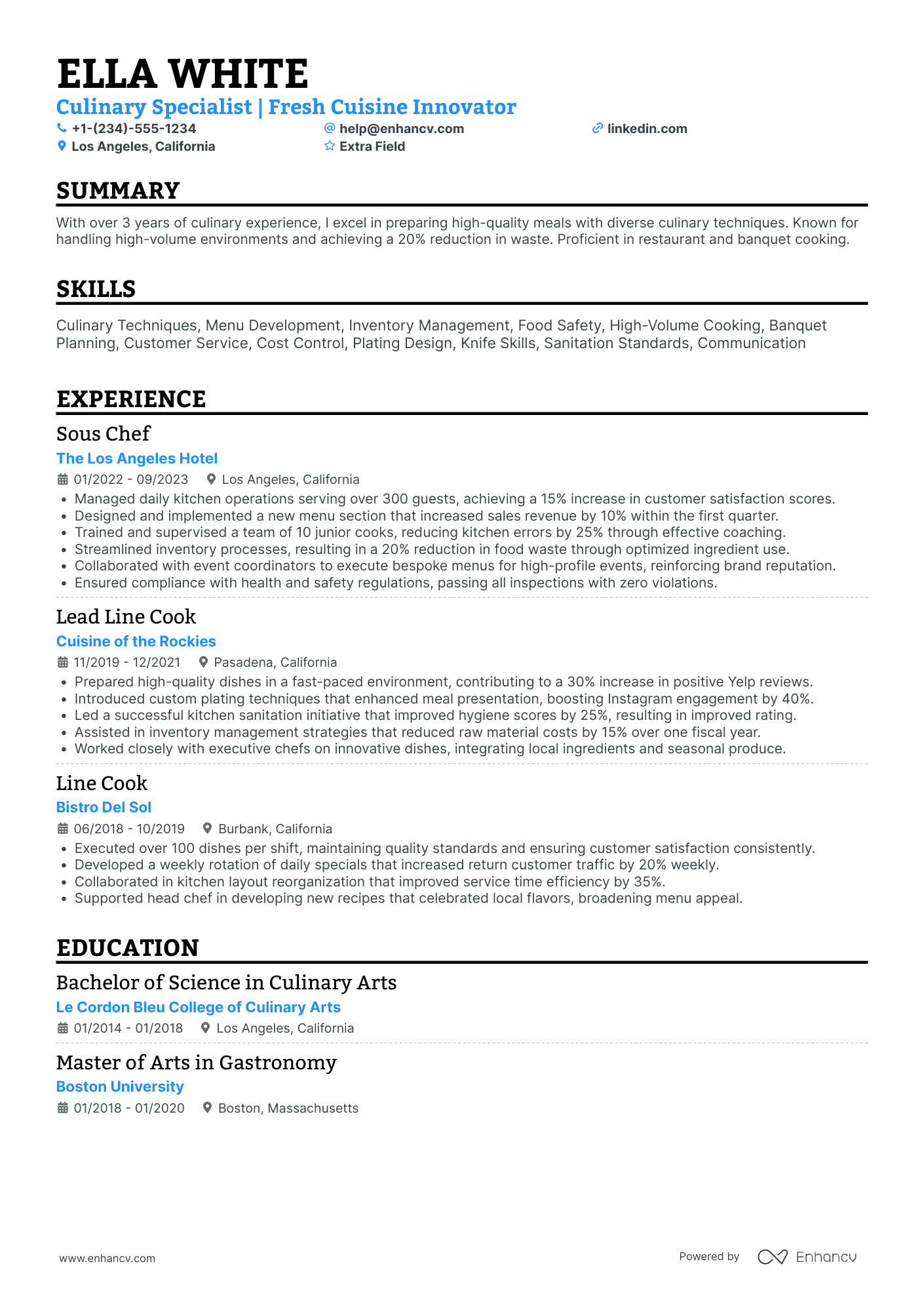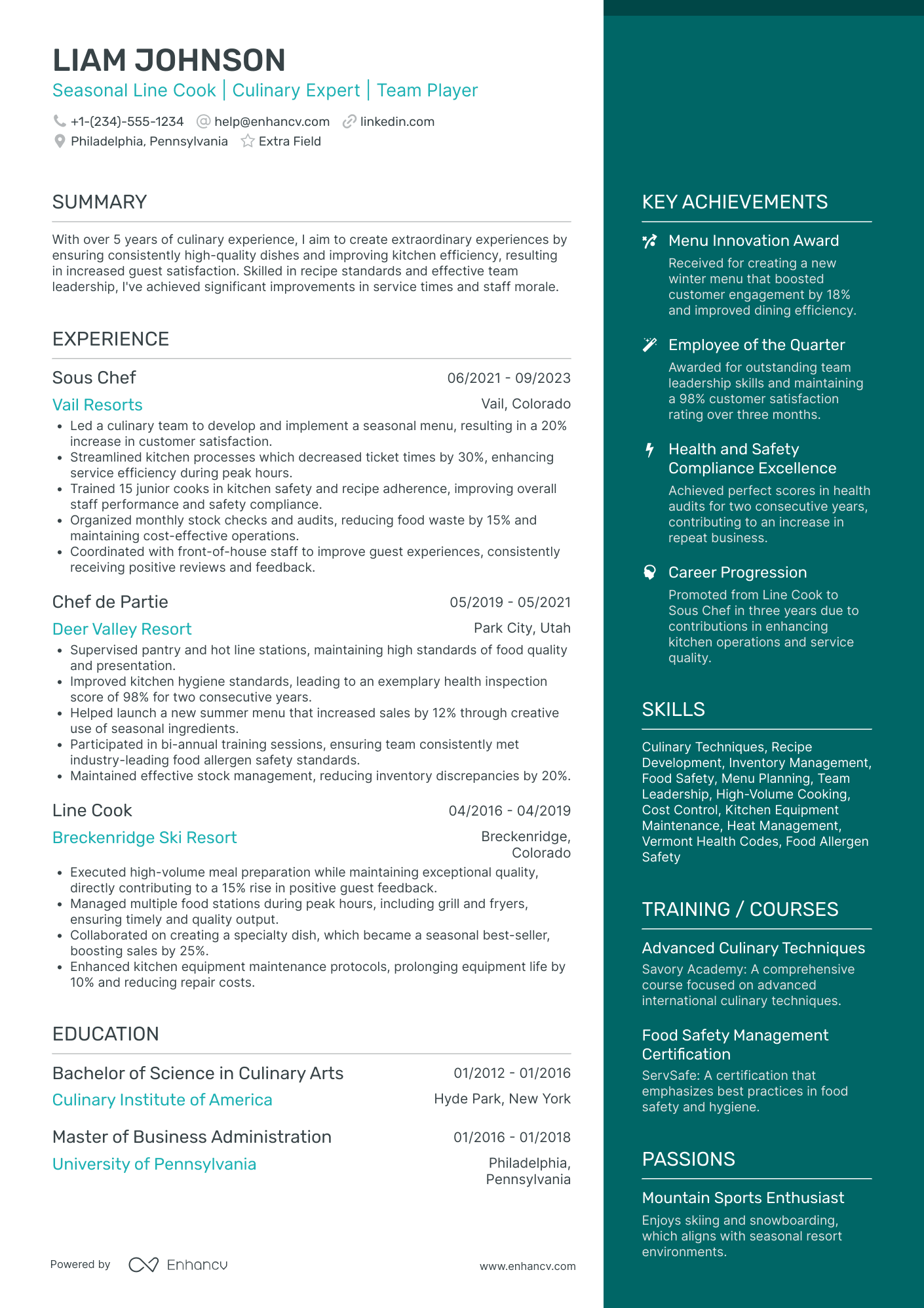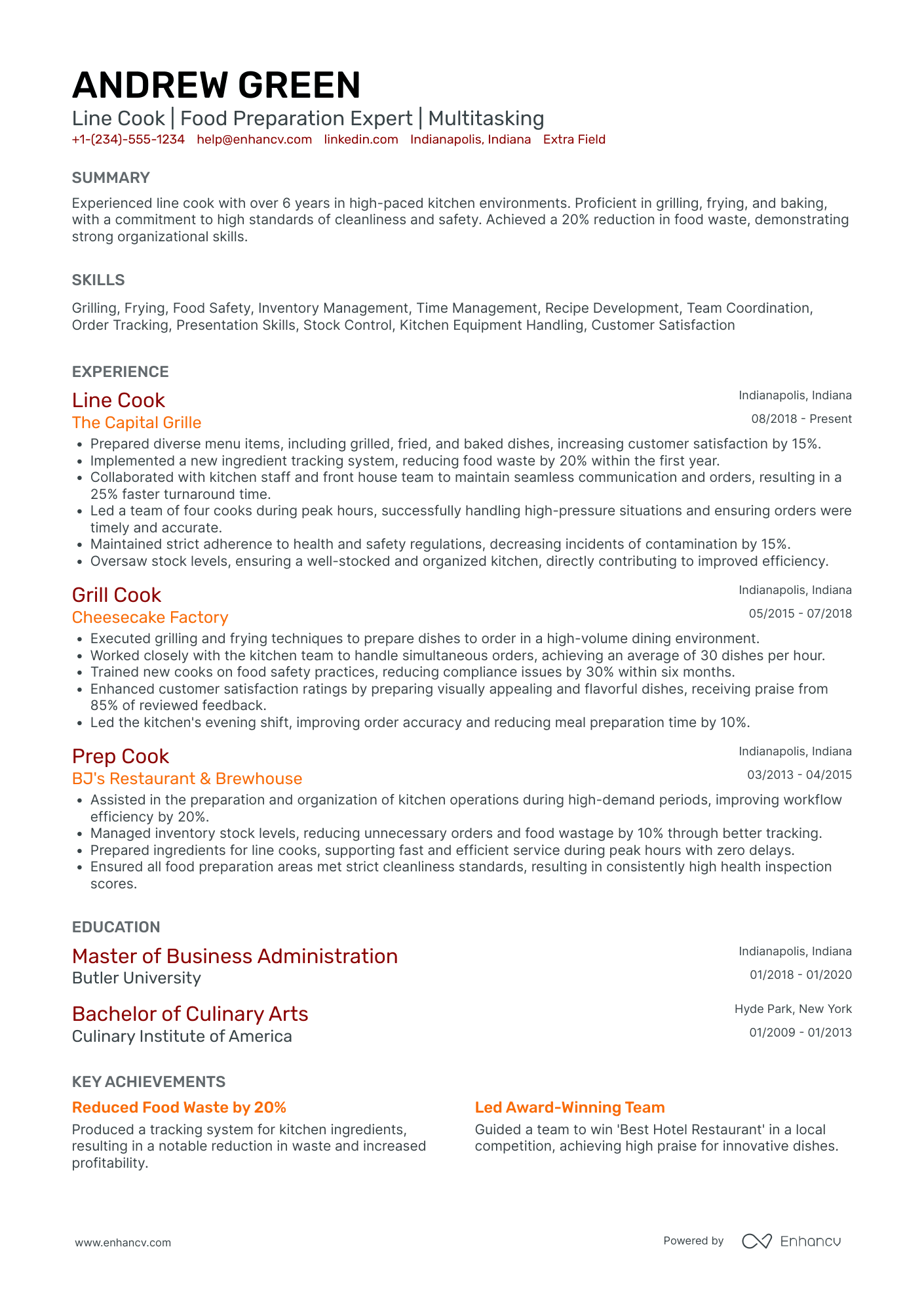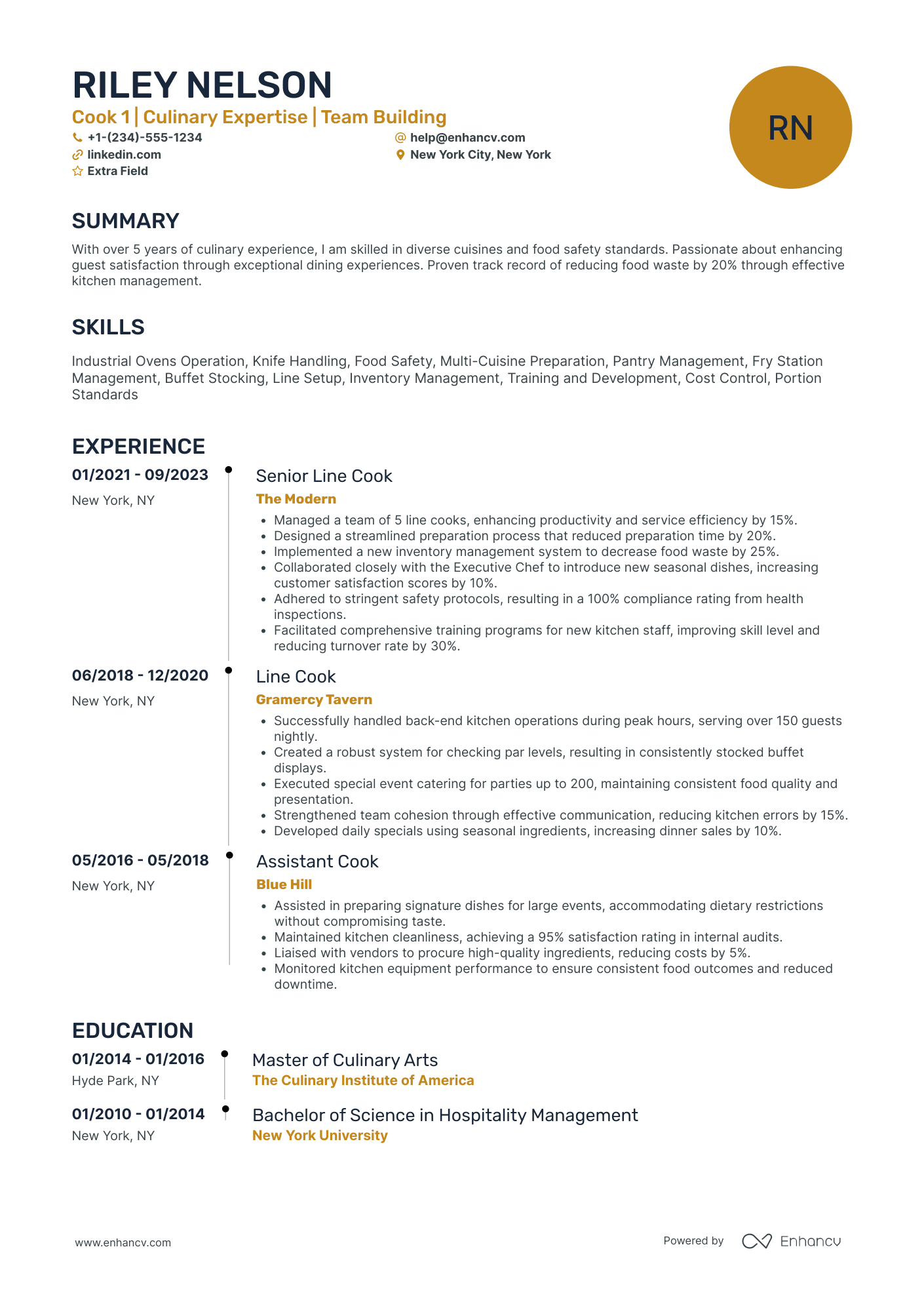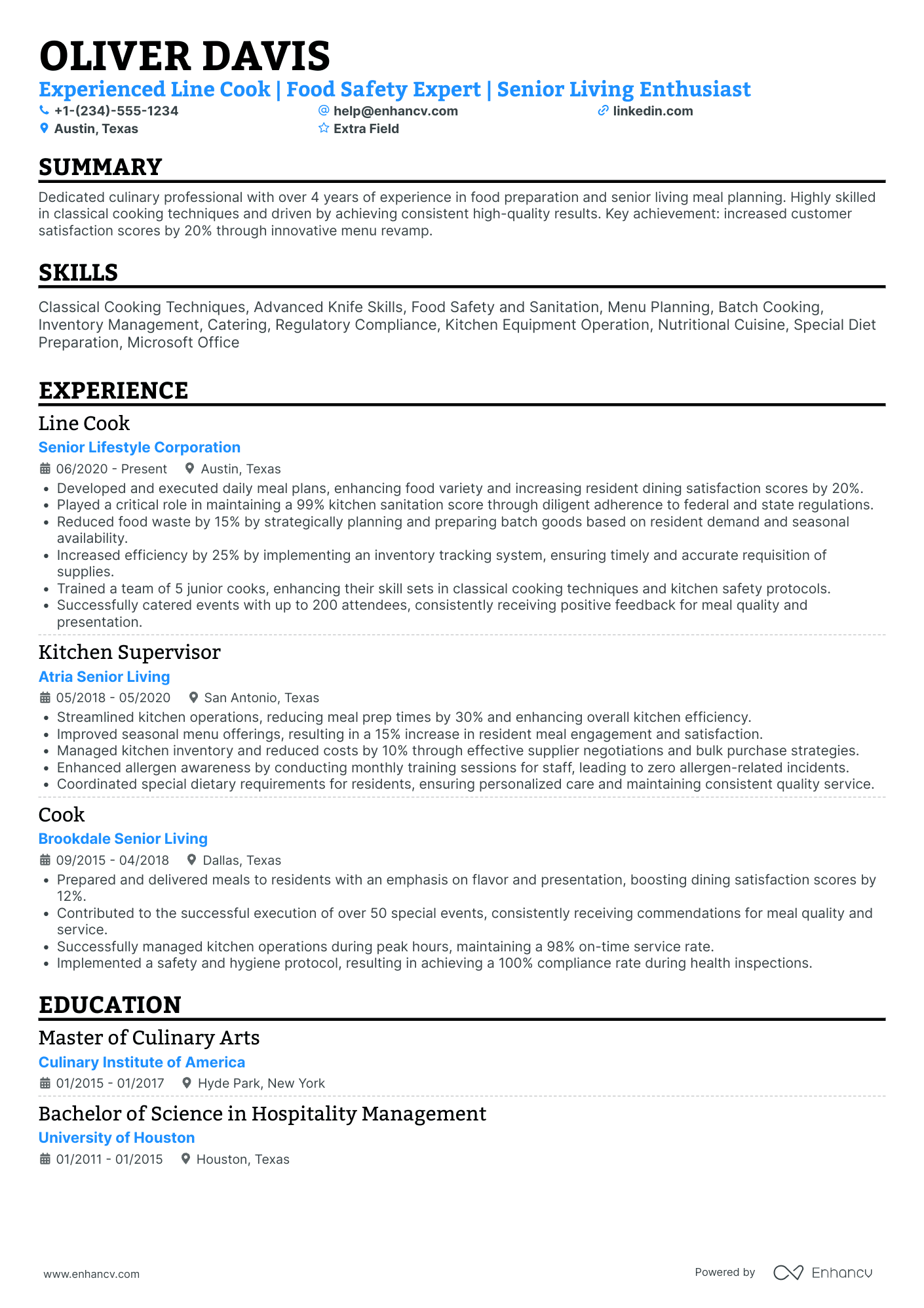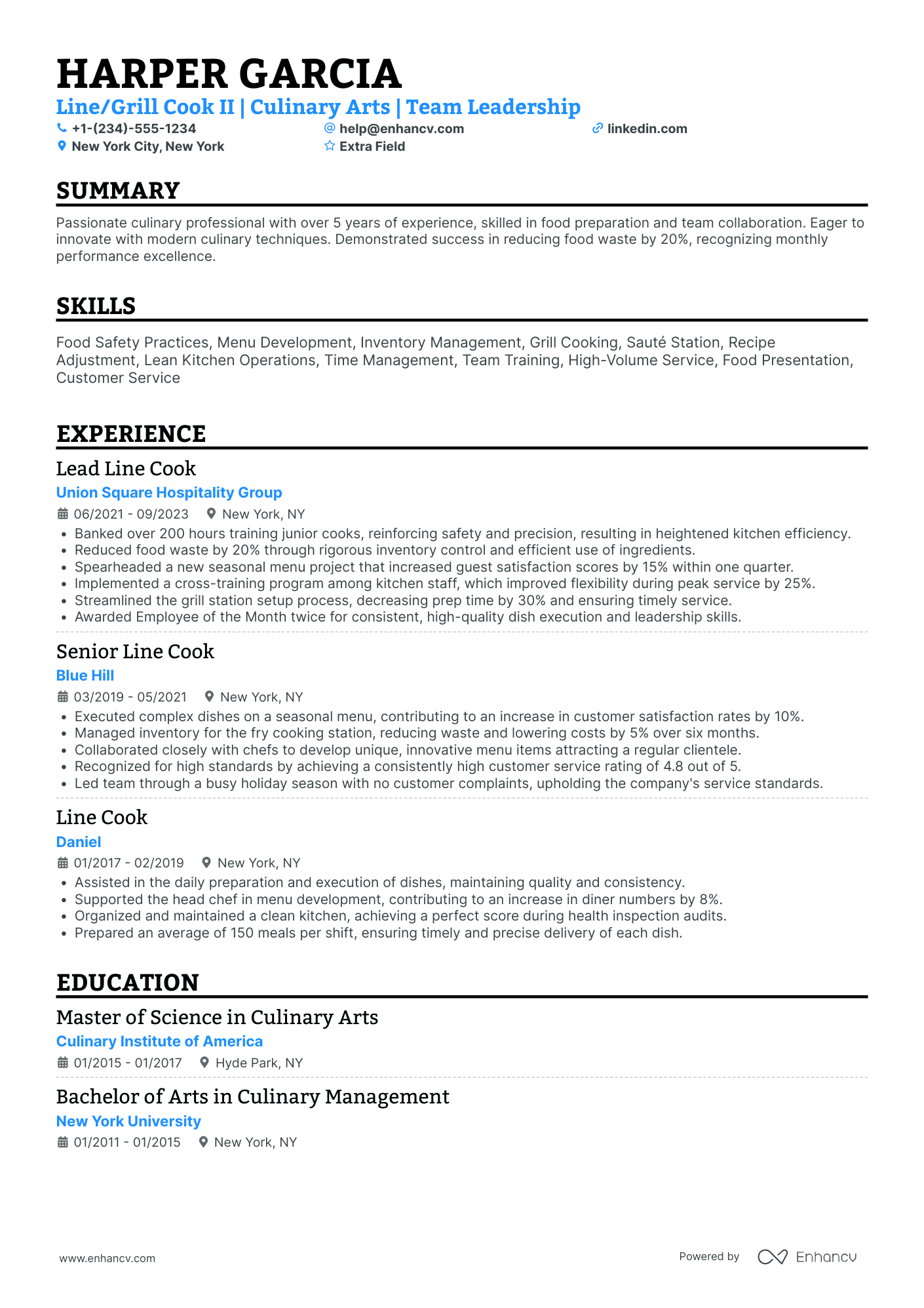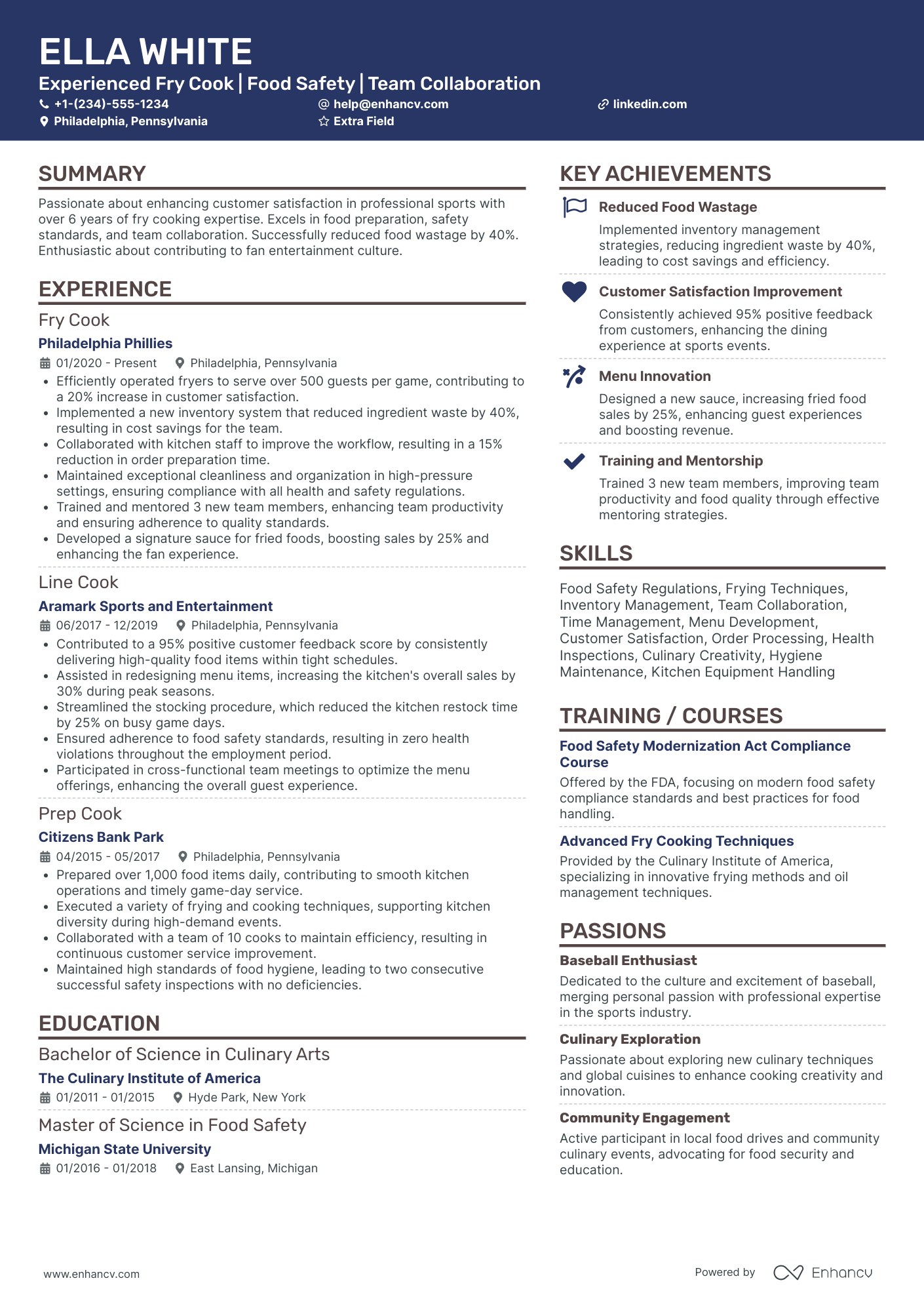Ever hear the phrase, “If you can’t take the heat, get out of the kitchen”? Well, as a line cook, handling the heat—both literal and figurative—is part of the job! Whether you’re expertly searing a steak or plating the perfect dish under pressure, your ability to multitask, stay organized, and work as part of a team makes all the difference.
The same skills apply when crafting a line cook resume. With competition for restaurant jobs high, hiring managers spend only a few seconds scanning each application. So how do you make your resume for a line cook stand out?
This guide will help you craft a compelling application by breaking down everything from line cook resume experience to line cook resume skills, complete with a resume example that shows you exactly how to do it.
Key takeaways
- Use a reverse-chronological format or functional format if you lack experience.
- Tailor your experience section to match recipe adherence, portion control, and kitchen safety.
- Quantify achievements like reducing prep time by 20% or maintaining 98% food safety compliance.
- List hard skills in a dedicated section and show soft skills in job descriptions.
- Certifications like ServSafe and HACCP boost your credibility and hiring potential.
- Highlight transferable skills, training, or projects if you lack direct employment history.
- Keep the design simple with one-inch margins, readable fonts, and a single-column layout.
- Add sections like awards, volunteer work, or professional development for extra value.
Before we dive in, take a look at a line cook resume example that goes beyond the usual resume template approach.
Line cook resume sample
Here’s a line cook resume sample that showcases the key ingredients of a strong application—highlighting skills, experience, and achievements that will help you stand out in a fast-paced kitchen environment.
Jared Fleming
Professional Line Cook
(763) 555-78XX | jared.fleming@enhancv.com | @LinkedIn | Forest Lake, MN
Summary
Detail-oriented line cook with over 2 years of experience in high-volume kitchen environments. Skilled in safe food handling, recipe adherence, and kitchen organization. Known for maintaining a fast, efficient pace while upholding quality and food safety standards. Strong ability to work collaboratively with kitchen teams to ensure smooth service.
Experience
Line Cook
The Lakeview Grill | Forest Lake, MN
May 2022 – Present
- Prepared and plated 150+ meals per shift, maintaining 98% customer satisfaction based on quality and presentation.
- Maintained a clean and organized workstation, reducing prep time by 25% through improved ingredient stocking.
- Ensured kitchen safety, sanitation, and OSHA compliance, contributing to zero health violations during inspections.
- Collaborated with kitchen staff to cut food waste by 20% through optimized portioning and inventory rotation.
- Stocked supplies before peak hours, reducing service delays by 30%.
Prep Cook
Northwood Bistro | Forest Lake, MN
August 2020 – April 2022
- Assisted in daily prep of 200+ ingredients, ensuring a smooth workflow for 5+ line cooks.
- Supported line cooks during service by restocking and prepping ingredients, reducing service delays by 35%.
- Monitored kitchen equipment and reported maintenance needs, preventing 15+ potential service disruptions.
- Followed all safe food handling guidelines, ensuring a 99% compliance score in internal safety audits.
Education
Associate Degree in Culinary Arts
Saint Paul College | Saint Paul, MN
Graduated: 2020
Certifications
- ServSafe Food Handler Certification (2021)
- OSHA Kitchen Safety Training (2020)
Skills
- Line cook resume hard skills: Food preparation, grilling, sautéing, portion control, knife skills, food safety compliance
- Line cook resume soft skills: Teamwork, time management, adaptability, attention to detail, communication
Languages
- English (Fluent)
- Spanish (Basic)
Feel free to use this line cook resume sample to craft your own standout application with Enhancv’s resume builder.
Next, we’ll get into the meat of your resume—the format.
How to format a line cook resume
When applying for a line cook position, having a well-structured resume format is just as important as having strong kitchen skills. A clear, organized layout ensures that hiring managers can quickly find the key details that show you're the right fit for the role.
Best resume format for a line cook
- Use a reverse-chronological format if you have prior line cook experience, as it highlights your most recent and relevant roles first.
- If you have little to no experience, consider a functional resume format focusing on skills and certifications rather than work history. This allows you to emphasize your culinary training, food safety knowledge, and transferable skills.
- We’ll explore the best approach for writing a line cook resume with no experience later in this guide.
Resume design essentials
A clean and professional design guarantees readability and makes your resume look polished.
- Length: Keep your resume’s length to one page to focus on the most relevant details.
- Margins: Maintain 1-inch margins to ensure readability.
- Font: Choose clean, professional resume fonts like Arial, Calibri, or Rubik.
- Columns: Use a single-column layout to avoid formatting issues with Applicant Tracking Systems (ATS).
Contact information: what to include
Your resume header should be clear, professional, and easy to find so hiring managers can reach out quickly.
- Include your full name, job title, phone number, professional email, and location (city and state).
- Add your LinkedIn profile (if applicable).
- No need for a photo, unless specified by the employer.
- Place your contact information in the resume header so it's easy to find at a glance.
Applicant Tracking System
Fonts, colors, and columns don’t affect ATS parsing. What matters most is using keywords from the job description and correct formatting for dates and bullet points.
File formatting and naming convention
A properly saved and named resume promises to be opened correctly and look professional.
- Save your resume as a PDF to preserve the layout.
- Use a professional file name like "Jared_Fleming_Line_Cook_Resume.pdf".
Top sections for a line cook resume
Each section of your resume should clearly underline your qualifications and experience in the kitchen.
- Header (Contact Info & Job Title): So recruiters can quickly see who you are and how to reach you.
- Professional Summary or Objective: A concise introduction that highlights your key skills and experience.
- Work Experience: Showcases your relevant restaurant experience, achievements, and responsibilities
- Education & Certifications: Demonstrates your formal training and any industry-recognized credentials.
- Skills (Hard & Soft): Lists the technical and interpersonal skills needed for success as a line cook. Hard skills (like knife handling and food safety) should be detailed in the skills section, while soft skills (like teamwork and adaptability) are best displayed throughout your resume—especially in your job descriptions and summary.
- Languages (if applicable): Shines a light on additional communication skills that could be valuable in a diverse kitchen environment.
Want to see if your current resume can pass the grade? Try our free and fast AI resume checker and see!
Is your resume good enough?
Drop your resume here or choose a file. PDF & DOCX only. Max 2MB file size.
A properly formatted line cook resume template ensures your skills and experience are easily digestible—just like a perfectly plated dish. Now, let’s dive into crafting a compelling line cook resume work section.
How to write your line cook resume experience
The experience section of your resume is where you prove your ability to work in a fast-paced, high-pressure kitchen environment. Hiring managers aren’t just looking for someone who can cook—they want a team player who understands food safety, efficiency, and quality standards.
A generic work history section won’t stand out in a stack of resumes. Instead, you need to tailor your resume to the job description by emphasizing the skills and responsibilities that match the role.
Why tailoring your experience section matters
Customizing your line cook resume experience makes your application more relevant and impactful.
Here’s why:
- Shows you understand the job's needs: Aligning your past responsibilities with the line cook job description for a resume tells recruiters you know what’s required in a fast-paced kitchen.
- Highlights your relevant impact: Recruiters scan resumes quickly, so a targeted resume means they immediately see your most valuable contributions.
- Saves recruiters’ time: It makes it easier for hiring managers to identify you as a top candidate, increasing your chances of landing an interview.
How to structure your line cook resume experience
Follow these steps to create a clear, compelling work description section:
1. Read the job description carefully
- Identify key responsibilities and skills the employer is looking for.
- Look for words like “recipe adherence,” “portion control,” “teamwork,” and “food safety compliance.”
2. Use bullet points for clarity
- Each job entry should include 3-5 bullet points that describe your value.
- Start each bullet with a strong action verb (e.g., “Prepared,” “Maintained,” “Collaborated”).
3. Focus on achievements, not just duties
- Instead of saying “Cooked meals on the grill,” try “Grilled an average of 120 steaks per shift while ensuring consistent doneness and presentation.”
4. Quantify your experience where possible
- Metrics on your resume add credibility and show your impact.
Examples:
“Reduced food waste by 15% by optimizing portion sizes.”
“Helped serve 300+ guests per shift while maintaining 98% positive customer reviews on food quality.”
5. Keep it relevant
- Only list restaurant or food-related roles unless you’re entry-level.
- If transitioning from another industry, highlight transferable skills like teamwork, time management, and following procedures.
Now, let’s apply these principles to a real job description and craft an optimized line cook resume experience section.
Line Cook
Job Summary:
To produce and maintain the quality of menu items assigned to your station according to the company's menu recipes and specifications. To ensure the company's safety, sanitation, and food standards are met according to recipes, procedures, quality, and timeliness.
Job Responsibilities:
- Timeliness: Station ready to work at scheduled time and you are in proper uniform.
- Pace: Brisk and steady, organized, no unnecessary steps.
- Recipe Adherence: 100% recipe knowledge when prepping or assisting with any other production step.
- Portioning: Use scales, measuring spoons, recipe cards and perform portion control tests.
- Cleanliness: Maintain the kitchen and all of its equipment in a "like new" condition. Practice clean as you go!
- Productivity: Your productivity is measured, not only by the quality of what you do but by the quantity of work you complete in a specific time period.
- Organization skills are a must.
- Think ahead: Stock supplies before the rush.
- Show the ability for teamwork.
- Maintain a safe working environment and adhere to all OSHA guidelines.
- Safe food handling.
- Receiving, rotating, and stocking food.
- Prep support as needed.
Knowledge, Skills & Abilities:
- Ability to handle multiple tasks and balance fluctuating workload.
- Ability to work and communicate well with others.
- Attention to detail and ability to take initiative is a must.
- Responsible behavior and professional image.
- Must have a positive attitude.
- Safe food handling and safety is always a top priority.
- Must be a team player.
Qualifications:
- 2 years of work or related experience preferred.
- Must be able to work a flexible schedule of nights, days, weekends, and holidays.
Now, take a look at how this experience entry has been tailored to match the specific job posting above.
- •Prepared and plated an average of 150+ meals per shift, ensuring strict adherence to company recipes and portioning standards.
- •Maintained a clean and organized workstation, reducing prep time by 25% through efficient ingredient stocking.
- •Ensured compliance with OSHA regulations and food safety protocols, contributing to zero health violations during inspections.
- •Assisted in daily prep of over 200 ingredients, ensuring efficient service for kitchen staff during peak hours.
- •Monitored stock levels and organized ingredient rotation, reducing food waste by 20%.
- •Collaborated with line cooks and chefs to ensure smooth execution of orders and timely plating.
- •Supported kitchen operations by receiving, rotating, and stocking food supplies, improving organization and efficiency.
- •Maintained cleanliness of workstations, equipment, and utensils, ensuring compliance with sanitation standards.
- •Provided prep support as needed, including chopping, portioning, and assisting in recipe preparation.
This experience section aligns directly with the line cook job description, integrating key responsibilities, achievements, and quantifiable metrics to match the employer’s expectations.
By tailoring the content to highlight relevant skills and experience, this approach enhances resume relevance, improves ATS compatibility, and increases the chances of catching a hiring manager’s attention.
Need help tailoring your resume to that dream job? Try our free targeted resume tool to help you along!
How to quantify your experience on resume
Demonstrating your impact as a line cook with numbers helps recruiters see the value you bring to the kitchen. Instead of just listing duties, emphasizing measurable achievements—like improving prep efficiency, minimizing waste, or maintaining consistent dish quality—makes your resume more compelling.
Here are some effective ways to present your contributions:
- Reduced ingredient waste by 15% through precise portioning and improved stock rotation.
- Decreased average ticket time by 3 minutes by streamlining prep and cooking processes during peak hours.
- Maintained a 98% compliance rate in food safety inspections by consistently following sanitation and storage guidelines.
- Increased kitchen efficiency by 20% by implementing a better station organization system.
- Assisted in serving 300+ meals per shift, ensuring consistency in presentation and portion sizes.
You might be wondering, “If I follow all these steps, can I still land the job without relevant experience?” Let’s find out.
How do I write a line cook resume with no experience
If you're aiming to become a line cook but don’t have direct experience, don’t worry—you can still craft a resume that highlights your potential. The key is to focus on skills, training, and transferable experience that show you’re prepared for the role.
What to add instead of work experience
If you lack direct line cook resume experience, structure your resume strategically:
- Use a functional or hybrid resume format to emphasize skills and training rather than work history.
- Place education and certifications at the top to underscore your knowledge of food safety and kitchen operations.
- Include any volunteer work or personal cooking experience, such as preparing meals for events, working at a community kitchen, or helping with family-owned food businesses.
- Showcase transferable skills from other jobs, like time management, teamwork, and working under pressure.
- Add a projects section to highlight any culinary training, coursework, or self-taught cooking skills.
Why use a resume objective in place of a summary?
A resume summary is best for experienced cooks, while a resume objective is a better choice for those without direct line cook experience. A strong objective helps recruiters understand your career goals, key skills, and enthusiasm for the role.
Tips for writing a line cook resume objective
- Keep it short and to the point—mention your career goals, relevant skills, and commitment to learning.
- Illustrate transferable skills such as attention to detail, ability to work under pressure, and food safety knowledge.
- Show enthusiasm by expressing your passion for the culinary industry.
Here’s an example that encompasses our tips:
By structuring your resume this way, you’ll shift the focus from experience to ability, making you a strong candidate—even without prior restaurant work.
The next step in crafting your resume is how to present your skill set to impress—let’s go on to explore that.
How to list your hard and soft skills on your resume
A well-balanced mix of hard and soft skills is essential for a strong line cook resume. Whether you’re an experienced cook or just starting out, showcasing the right food-service skills helps demonstrate your ability to thrive in a fast-paced kitchen.
Hiring managers want to see not only your technical expertise but also your ability to work efficiently with a team under pressure.
The difference between hard and soft skills
Hard skills are technical abilities that can be learned, measured, and often certified. These include things like knife handling, food safety procedures, and plating techniques.
Soft skills are personal traits that influence how you work with others and handle challenges. These involve qualities like time management, teamwork, and attention to detail—all crucial in a high-pressure kitchen environment.
Where to place skills on your resume
- Hard skills should go in a clearly labeled section, such as “Technical Skills” or “Core Competencies,” to make them easy to find.
- Soft skills should be naturally woven into your experience section, resume summary, and cover letter to show how you apply them in a work setting.
To build a well-rounded resume, take a look at industry-recognized hard and soft skills that hiring managers value. Browse reputable resources on food safety standards, kitchen efficiency techniques, and culinary certifications to strengthen your skill set before applying.
Now, let’s look at the top hard and soft skills to feature on your line cook resume
Best hard skills for your line cook resume
- Sous vide cooking
- Commercial deep fryers
- Flat-top griddles
- Gas and induction stovetops
- Broilers and salamanders
- Industrial convection ovens
- Blast chillers
- Vacuum sealers
- Kitchen display systems (KDS)
- Point of sale (POS) systems
- Food processors
- Immersion blenders
- Meat slicers
- Digital food thermometers
- Knife sharpening systems
- Industrial dishwashers
- Walk-in refrigeration systems
- HACCP compliance software
- Portion control scales
- Automated inventory management systems
Best soft skills for your line cook resume
- Time management
- Teamwork
- Attention to detail
- Multitasking
- Communication
- Problem-solving
- Stress management
- Organization
- Work ethic
- Customer service
- Active listening
- Conflict resolution
- Creativity
- Flexibility
- Patience
- Leadership
- Initiative
- Dependability
- Collaboration
Now that we’ve covered the essential skills for a line cook resume, let’s take a look at how to present your education and certifications to strengthen your application.
How to list your certifications and education on your resume
For a line cook, experience and certifications often carry more weight than formal education. However, including an education section can still be valuable—especially if you have culinary training or food safety coursework.
Even if you don’t have a degree related to cooking, showcasing certifications like ServSafe Food Handler or HACCP Compliance can strengthen your application and demonstrate your qualifications.
What to provide in your education section
If your education is relevant to the role, keep it concise and structured:
- Degree or Diploma Name
- School Name
- Graduation Year (No need to include the month)
- Relevant coursework (if applicable, such as food safety or culinary arts)
If you don’t have a formal culinary education, you can still list training programs or workshops related to kitchen safety, food preparation, or restaurant management.
Since practical knowledge is more important for line cook resumes, let’s now focus on certifications that can set you apart from other candidates.
Certifications on a resume prove your ability to follow food safety regulations, maintain kitchen cleanliness, and handle food properly. If you hold multiple certifications, include them in a separate section.
Best certifications for your line cook resume
- ServSafe Food Handler Certification
- HACCP Certification (Hazard Analysis and Critical Control Points)
- Certified Professional Cook (CPC)
- OSHA Food Safety Certification
- Culinary Arts Certificate
These credentials demonstrate that you’re qualified to work in a professional kitchen while ensuring food quality and safety standards are met.
Now that we’ve covered education and certifications, let’s move on to crafting a strong resume summary for a line cook.
How to write your line cook resume summary
A resume summary is one of the first things a hiring manager sees, making it a crucial section of your line cook resume. In just a few lines, it should convey your culinary skills, efficiency in a fast-paced kitchen, and ability to maintain quality under pressure.
Your summary should:
- Highlight your experience level (e.g., years worked in kitchens or specific types of restaurants).
- Emphasize key skills like food preparation, safety compliance, and teamwork.
- Quantify achievements to show impact (e.g., reducing prep time, and handling a high volume of meals per shift).
- Provide certifications if relevant (e.g., ServSafe Food Handler).
Have a look below at a good example of a resume summary targeted at the job advert from earlier.
This summary is concise, impactful, and tailored to the job—underlining key skills, experience, and quantifiable results that make the candidate stand out.
Now, let’s explore additional resume sections that can further strengthen your application.
Optimize your resume summary and objective for ATS
Drop your resume here or choose a file.
PDF & DOCX only. Max 2MB file size.
Additional sections for a line cook resume
While the core sections of your line cook resume cover experience, skills, and certifications, adding optional sections can help you stand out. These sections provide more insight into your background and showcase qualities that may set you apart from other candidates.
Our recommendations are:
- Awards & recognition: Highlight any achievements, such as Employee of the Month or impressive awards for efficiency, teamwork, or food presentation.
- Volunteer experience: If you've helped in community kitchens, food banks, or charity events, this shows dedication to food service beyond the workplace.
- Professional development: List relevant workshops, culinary training programs, or ongoing education that enhances your skills.
- Hobbies & interests: If you enjoy cooking outside of work, such as baking, food blogging, or experimenting with new recipes, it can demonstrate passion for the industry.
- Foreign languages: Knowing multiple languages can be beneficial in diverse kitchen environments and improve communication with team members.
Including relevant optional sections can help personalize your resume and give hiring managers a well-rounded view of your skills and interests.
In conclusion
A well-structured line cook resume emphasizes your skills, experience, and certifications to show hiring managers you can thrive in a fast-paced kitchen. By tailoring each section— from your work experience to hard and soft skills—you increase your chances of standing out and landing your next culinary role.
To be a cook is one of the oldest and noblest professions known to mankind. Every cook should take pride in this realization.
Paul Sorgule, chef, educator, consultant, and author


